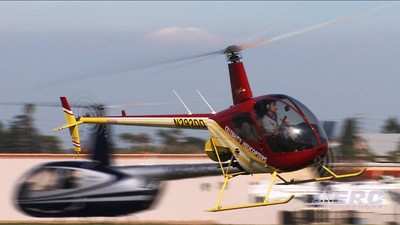Student Pilot Survived With Serious Injuries, Instructor Killed
A training flight in a Robinson R22 Beta helicopter in Lake Worth, FL turned into a fatal accident late last month, and the NTSB has released its preliminary report based on its investigation to date which includes an interview with the student pilot, who survived the accident.

According to the report, on December 29, 2014, at 1025 eastern standard time, a Robinson R22 Beta, N771MM, was substantially damaged when it impacted terrain while maneuvering for landing at Palm Beach County Park Airport (KLNA), Lake Worth, FL. The certificated flight instructor (CFI) was fatally injured, and the student pilot sustained serious injuries. Visual meteorological conditions prevailed, and no flight plan was filed for the local instructional flight, which departed about 0940. The flight was conducted under the provisions of Title 14 Code of Federal Regulations Part 91.
In a statement to law enforcement, the student pilot recounted that he and the CFI were practicing emergency procedures following a simulated engine failure. The student pilot said that he entered an autorotation after the throttle was reduced to idle, and the helicopter was in an autorotational descent when the accident occurred. He could not completely recall the sequence of events leading up to the accident, but stated that as the helicopter descended through 100 feet, he remembered the CFI saying, "we're going down."
Another CFI, who was taxiing a helicopter with a student on the south side of LNA, reported hearing the accident helicopter transmit, "we're going in the grass" over the airport's common traffic advisory frequency. Shortly thereafter, an airplane in the airport traffic pattern reported that there was a helicopter down, and the CFI flew to the accident site to render assistance.
The helicopter came to rest on its left side in a grassy area about 700 feet northwest of the runway 15 threshold at LNA. The wreckage path was oriented approximately 140 degrees magnetic, and extended about 75 feet from the initial impact point to where the fuselage came to rest. The initial impact point was identified as a large metal stake, about 3 feet in height. The second point of impact was a small crater measuring about 4 feet long and 1 foot deep, located about 15 feet past the initial impact point. A portion of the forward skid crosstube was located in the crater. The vertical stabilizer, horizontal stabilizer, and portion of the tail rotor came to rest next to the crater. The tail boom was separated from the fuselage, and fractured into several pieces, some of which displayed signatures consistent with main rotor blade contact. The skids separated from the fuselage and were fractured into several sections, which were located along the wreckage path.

The fuselage exhibited downward crushing, and the cabin was fractured aft of the seat structures. Both the auxiliary and main fuel tanks were intact and contained fuel, and both fuel caps were secure. The fuel vent tubes were separated from the auxiliary tank by impact, which allowed fuel to drain from the tanks following the accident.
The main rotor remained attached to the fuselage. One blade was bent up and displayed several chordwise creases along its span. The second blade was bent up about 45 degrees near its root. Neither blade displayed significant leading edge damage. The tail rotor drive shaft separated from the helicopter during the accident sequence, and a 5-foot portion was located about 500 feet west of the main wreckage. The aft portion of the tail rotor drive shaft was not recovered.
The helicopter was removed from the accident site and transported to a salvage facility for further examination. Flight control continuity was confirmed from the cockpit area to the main rotor system. Tail rotor control continuity was established from the cockpit to the intermediate flex coupling. The main rotor gearbox rotated smoothly by hand with no anomalies observed. Examination of the v-belts, sheaves, and overrunning clutch also revealed no anomalies.
Tail rotor drive continuity was established from the upper drive sheave to the intermediate flex coupling. The tail rotor gearbox rotated smoothly, with no anomalies noted. Power was applied to the engine starter, and utilizing the fuel onboard, the engine started, accelerated smoothly, and ran continuously for several minutes with no anomalies noted.
(Image from file. Not accident aircraft)
 ANN's Daily Aero-Term (04.30.24): Runway Centerline Lighting
ANN's Daily Aero-Term (04.30.24): Runway Centerline Lighting ANN's Daily Aero-Linx (04.30.24)
ANN's Daily Aero-Linx (04.30.24) Airborne 04.24.24: INTEGRAL E, Elixir USA, M700 RVSM
Airborne 04.24.24: INTEGRAL E, Elixir USA, M700 RVSM Airborne 04.29.24: EAA B-25 Rides, Textron 2024, G700 Deliveries
Airborne 04.29.24: EAA B-25 Rides, Textron 2024, G700 Deliveries Airborne-NextGen 04.23.24: UAVOS UVH 170, magni650 Engine, World eVTOL Directory
Airborne-NextGen 04.23.24: UAVOS UVH 170, magni650 Engine, World eVTOL Directory




